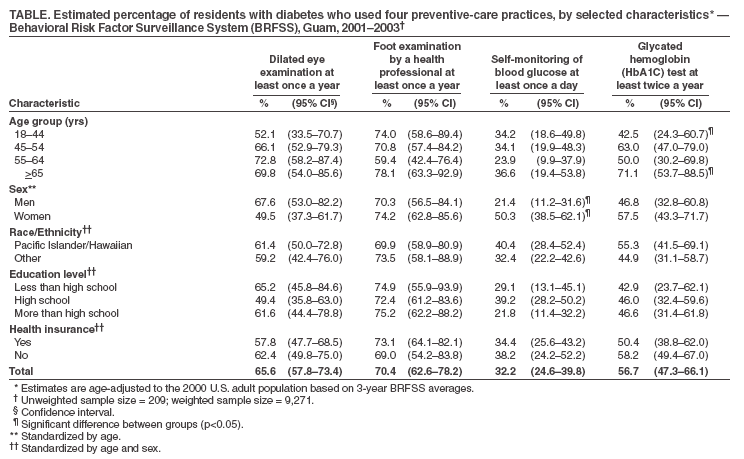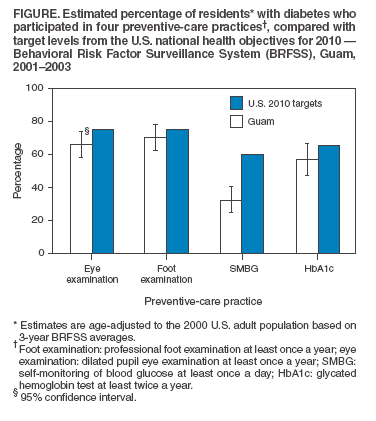 |
|
|
|
|
|
|
| ||||||||||
|
|
|
|
|
|
|
||||
| ||||||||||
|
|
|
|
|
Persons using assistive technology might not be able to fully access information in this file. For assistance, please send e-mail to: mmwrq@cdc.gov. Type 508 Accommodation and the title of the report in the subject line of e-mail. Diabetes-Related Preventive-Care Practices --- Guam, 2001--2003Persons with diabetes are at risk for serious complications, such as blindness, kidney failure, nontraumatic lower-extremity amputations, and cardiovascular disease (1). Preventive-care practices have been determined effective in reducing both the incidence and progression of diabetes-specific complications (2,3). Despite the benefits of these practices, their level of use has been lower than recommended in the United States (4). To emphasize the importance of preventive-care practices, national health objectives for 2010 for persons with diabetes, include the following targets: have an annual dilated eye examination (75%; objective 5-13), have an annual foot examination (75%; objective 5-14), perform self-monitoring of blood glucose (SMBG) at least once daily (60%; objective 5-17), and have a glycated hemoglobin (HbA1c) measurement at least twice per year (65%; objective 5-12 [revised]) (5). In the U.S. territory of Guam (2004 population: 166,090), no previous population-based assessment of the use of diabetes-related preventive-care practices has been conducted. For this report, data from the 2001--2003 Guam Behavioral Risk Factor Surveillance System (BRFSS) were analyzed to determine the prevalence of preventive-care practices among persons with diabetes in Guam, which is the southernmost and largest of the Marianas Islands, located approximately 3,300 miles west of Hawaii and 1,550 miles south of Japan. Results of the analysis indicated that Guam residents with diabetes remain below the national targets for 2010 for four preventive-care practices, most notably SMBG. The preventive care programs and surveillance activities of the Guam Diabetes Prevention and Control Program (DPCP) should be continued, with emphasis on SMBG recommendations, to prevent poor health outcomes in persons with diabetes and achieve the national health objectives. The Guam BRFSS is an ongoing, random-digit--dialed telephone survey of noninstitutionalized civilian adults aged >18 years. CASRO response rates were 54.4% in 2001, 52.7% in 2002, and 36.2% in 2003. The total number of respondents for the 3 years combined was 2,484 (861 in 2001, 825 in 2002, and 798 in 2003). Participants were those who answered "yes" to the question, "Has a doctor ever told you that you have diabetes?" Women who were told they had diabetes only during pregnancy were classified as not having diabetes. A total of 209 persons (67 from 2001, 63 from 2002, and 79 from 2003) were included in the analysis; they were asked the following four questions: "When was the last time you had an eye exam in which the pupils were dilated?" "About how many times in the last year has a health professional checked your feet for any sores or irritations?" (Persons who indicated having bilateral amputations were not asked this question.) "About how often do you check your blood for glucose or sugar?" "About how many times in the last year has a doctor, nurse, or other health professional checked you for glycated hemoglobin or hemoglobin `A one C'?" Data were weighted to reflect the age, sex, and racial distribution of the adult, noninstitutionalized population of Guam; all estimates were age-adjusted to the 2000 U.S. adult population. Statistical analysis software was used to calculate estimates and 95% confidence intervals (CIs); t-tests were used to determine significant differences between groups. The estimated prevalence of diabetes during 2001--2003 among adults in Guam was 11%. A total of 65.6% (95% CI = 57.8%--73.4%) reported having annual eye examinations, 70.4% (CI = 62.6%--78.2%) reported having annual foot examinations, 32.2% (CI = 24.6%--39.8%) reported performing daily SMBG, and 56.7% (CI = 47.3%--66.1%) reported having their HbA1c measured at least twice annually (Table). Men were significantly (p<0.05) less likely than women to report daily SMBG (21.4% [CI = 11.2%--31.6%] versus 50.3% [CI = 38.5%--62.1%]); persons aged 18--44 years were significantly less likely than persons aged >65 years to report having their HbA1c measured at least twice annually (42.5% [CI = 24.3%--60.7%] versus 71.1% [CI = 53.7%-- 68.5%]) (Table). The percentages of Guam residents with diabetes were below all four U.S. national targets for 2010 for diabetes-related preventive care (Figure). For comparison, the Guam percentages for eye and foot examinations were higher than U.S. national estimates for 2003 (65.6% versus 61.3% and 70.4% versus 67.4%, respectively). However, the Guam percentages trailed U.S. estimates substantially in HbA1c measurements and SMBG (56.7% versus 65.9% and 32.2% versus 58.3%, respectively) (6). Reported by: G Suguitan, MPA, Guam Dept of Health. KY McDuffie, PhD, Div of Public Health Partnerships, National Center for Health Marketing; R Valdez, PhD, G Beckles, MD, D Glover, MSW, S Benjamin, PhD, Div of Diabetes Translation, National Center for Chronic Disease Prevention and Health Promotion, CDC. Editorial Note:The findings in this report represent the first population-based assessment of preventive-care practices among persons with diabetes in Guam; the results might be compared with those of future analyses to track progress toward the targets established in the U.S. national health objectives for 2010. During 2001--2003, for all four diabetes-related preventive- care practices analyzed, the percentages of Guam residents reporting adherence to the recommended practices were below the national targets for 2010. For HbA1c measurements and eye and foot examinations, the percentages of Guam residents with diabetes were substantially closer to the national targets than the percentage of persons who reported performing SMBG at least once a day. Success with SMBG requires incorporation of the practice into a person's daily routine, which might be more challenging than scheduling and following through with annual and semiannual appointments with health-care providers. Therefore, the Guam DPCP might need to focus its efforts more closely on self-management of diabetes, including daily SMBG. The findings in this report are subject to at least four limitations. First, because persons residing in long-term--care facilities and in households with no telephone or only a cellular telephone are not included in BRFSS surveys, results cannot be generalized to these segments of the population. Second, because data are self-reported, they are subject to recall bias and might be under- or overreported. However, previous studies indicated that self-reports of diabetes and dilated eye examinations were accurate (7,8), self-reports of SMBG were determined to be reliable in a study of persons with type 1 diabetes (9), and self-reports of HbA1c measurements had high sensitivity and low specificity in another study (10). Further investigation is needed into the reliability and validity of self-reports of foot examinations among persons with diabetes and SMBG among persons with type 2 diabetes. Third, the small sample size resulted in the ability to detect only two statistically significant differences in preventive-care practices among persons grouped by selected characteristics. When more data become available, a similar analysis should be conducted to compare findings with the results in this report. Finally, the response rate (36.2%) to the Guam BRFSS survey was substantially lower in 2003 than in 2001 and 2002. This resulted from miscoding of thousands of telephone numbers as busy instead of as nonworking, increasing the denominator of the response rate. The problem, which did not affect the quality of the data, has since been corrected. CDC has taken an active role in improving the quality of care among persons with diabetes through its state- and territorial-based DPCPs. These programs provide leadership for a coordinated, multifaceted approach to increasing awareness about diabetes, educating persons about diabetes, improving the quality of diabetes care, promoting early detection of diabetic complications, and monitoring trends in the quality of care received by persons with diabetes. Guam DPCP works with local public health programs such as the Maternal/Child Health Program and the Special Supplemental Nutrition Program for Women, Infants, and Children, home health-care organizations, the Diabetes Network, civic groups, and local health-care providers to improve preventive health care by 1) developing low-literacy educational brochures and posters in English, Tagalog, and Chamorro; 2) hosting island-wide diabetes conferences; and 3) sponsoring training for health-care providers. In addition, CDC and the National Institutes of Health jointly sponsor the National Diabetes Education Program (NDEP), which develops educational tools and community-based interventions and establishes public- and private-sector partnerships to address the needs of persons with diabetes and raise general awareness about the disease. NDEP (http://www.ndep.nih.gov) also seeks to improve diabetes prevention, treatment, and outcomes and to promote early detection. Guam DPCP has teamed with NDEP to conduct several nutrition and cooking education classes for persons with diabetes and their families. Finally, Guam DPCP, in coordination with the Bureau of Primary Care Services, actively participates in the Diabetes Health Disparities Collaborative (http://www.healthdisparities.net/hdc/html/collaboratives.topics.diabetes.aspx), which aims to achieve optimal results with diabetes-related preventive-care practices, including HbA1c testing, diabetes education, foot examination, dilated eye examination, cholesterol screening, influenza and pneumoccoccal vaccines, and urine protein tests. References
Table  Return to top. Figure  Return to top.
Disclaimer All MMWR HTML versions of articles are electronic conversions from ASCII text into HTML. This conversion may have resulted in character translation or format errors in the HTML version. Users should not rely on this HTML document, but are referred to the electronic PDF version and/or the original MMWR paper copy for the official text, figures, and tables. An original paper copy of this issue can be obtained from the Superintendent of Documents, U.S. Government Printing Office (GPO), Washington, DC 20402-9371; telephone: (202) 512-1800. Contact GPO for current prices. **Questions or messages regarding errors in formatting should be addressed to mmwrq@cdc.gov.Page converted: 4/7/2005 |
|||||||||
This page last reviewed 4/7/2005
|